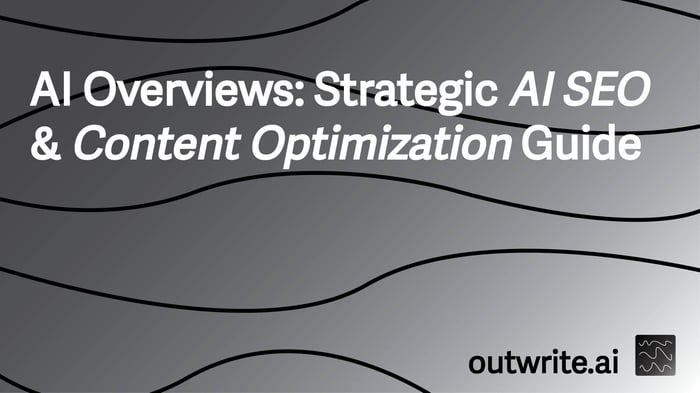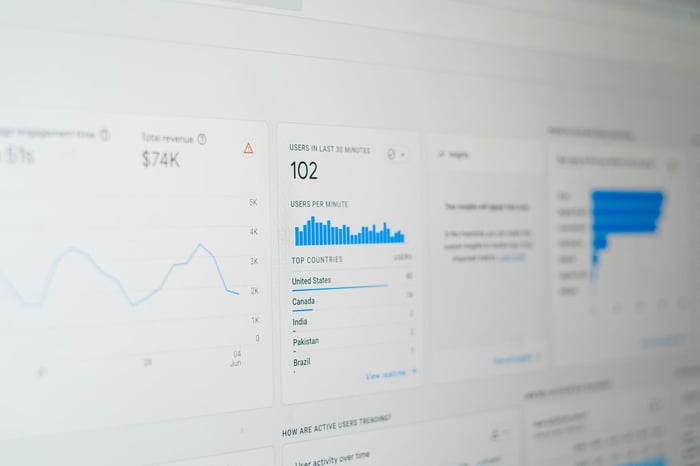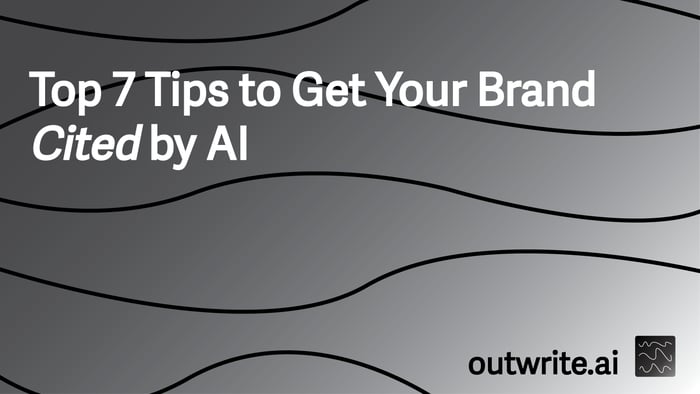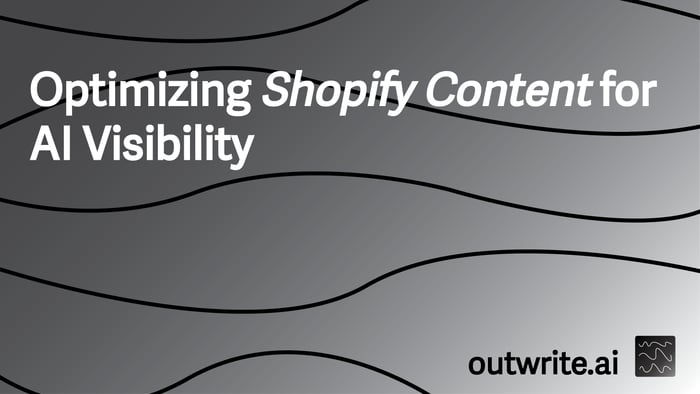Table of Contents
- Understanding AI Overviews and SGE
- AI-Driven Content Strategy for Inclusion
- Semantic SEO and Structured Data
- Quality, E-E-A-T, and Trustworthiness
- Optimizing for Zero-Click Searches
- AI Content Creation Best Practices
- Measuring AI Overview Performance
- Case Studies: AI SEO Success in Action
- Future-Proofing for Evolving AI Search
- Frequently Asked Questions (FAQ)
- Conclusion
Google's AI Overviews, powered by its Search Generative Experience (SGE), are transforming how users find information. This shift demands a new approach to SEO and content optimization. Businesses must adapt their strategies to ensure their content is not only discoverable but also prioritized by AI technology for inclusion in these prominent search results.
This guide explores strategic techniques for optimizing content for AI Overview inclusion. We cover leveraging AI tools, understanding user intent, enhancing content quality, and measuring performance. Our goal is to help you secure top visibility in the evolving AI search landscape.
Understanding AI Overviews and SGE
AI Overviews represent a significant evolution in search. Google's Search Generative Experience (SGE) uses generative AI to synthesize information from various sources, providing concise answers directly within the search results. This changes how users interact with search engines and how content creators must optimize their work.
For small websites, this presents both a challenge and an opportunity. Appearing in an AI Overview can drive significant visibility, even if your site isn't the top organic result. Understanding the mechanics of AI Overviews is the first step toward strategic optimization.
For more expert guidance, check out Why AI Visibility Outweighs Traditional Keyword Focus for Digital Content
What are AI Overviews?
AI Overviews are AI-generated summaries that appear at the top of Google Search results for certain queries. They aim to provide direct, comprehensive answers by pulling information from multiple web pages. This feature reduces the need for users to click through to individual websites for basic information, leading to more "zero-click searches."
These summaries often include citations to the source websites, offering a new pathway for traffic. Optimizing for these citations is crucial for maintaining and growing organic reach. The content needs to be highly relevant, authoritative, and structured for AI consumption.
Why are AI Overviews Important for SEO?
AI Overviews fundamentally alter the search engine results page (SERP) landscape. They can capture significant user attention, potentially reducing clicks to traditional organic listings. For content creators, this means earning a spot in an AI Overview becomes a primary SEO goal.
- Increased Visibility: Content cited in an AI Overview gains prime real estate at the top of the SERP.
- Enhanced Authority: Being chosen by Google's AI as a source signals high trustworthiness and relevance.
- New Traffic Channels: While some searches become zero-click, citations in Overviews can still drive targeted traffic.
- Adaptation to AI Technology: Staying competitive requires aligning with Google's advancements in AI search ranking.
The rise of AI Overviews emphasizes the need for content that directly answers user questions and provides clear, concise information. This aligns with Google's ongoing effort to deliver the most relevant and helpful results to its users.
Impact on Traditional SEO Metrics
The introduction of AI Overviews can shift traditional SEO metrics. While organic traffic might see changes, the quality of traffic from AI Overview citations could be higher, as users are seeking specific answers. Monitoring these shifts is vital for adapting your strategy.
According to AIOSEO, featured snippets (rich results), which are similar in concept to AI Overviews, rank with the highest click-through rate (CTR) at 42.9% AIOSEO. This highlights the immense value of content optimized to be cited in Google AI Overviews. Furthermore, 52% of sources cited in Google AI Overviews are ranked in the top 10 search results, underscoring the value of SEO best practices tailored for AI-curated content AIOSEO.
| Search Feature | Typical CTR Range | Impact on User Behavior | SEO Priority |
|---|---|---|---|
| Traditional Organic Links | 15-30% (Top 3) | Direct click-through to website | High (still foundational) |
| Featured Snippets | 42.9% (Highest) | Direct answer, often followed by click | Very High (direct answer optimization) |
| AI Overviews (SGE) | Variable (direct answer, citations) | Zero-click potential, but new citation traffic | Critical (content structure, authority) |
| Paid Ads | 2-10% (depending on industry) | Immediate visibility, direct conversion focus | Strategic (complementary to organic) |
AI-Driven Content Strategy for Inclusion
Developing an AI-driven content strategy means creating content that AI technology can easily understand, process, and present in an AI Overview. This involves a deep understanding of user intent, semantic optimization, and leveraging AI tools for content creation and analysis. The goal is to produce content that is not just human-readable but also AI-digestible.
A successful strategy integrates AI technology throughout the content lifecycle, from ideation to optimization. This ensures alignment with the evolving demands of AI search ranking and maximizes the chances of AI Overview inclusion.
Understanding User Intent with AI
AI Overviews are designed to answer user questions directly. Therefore, understanding and addressing user intent is paramount. AI tools can analyze search queries and identify the underlying intent more accurately than traditional keyword research alone. This allows for the creation of highly targeted content.
- Identify Question-Based Queries: Focus on "how-to," "what is," "why," and "when" questions that AI Overviews frequently answer.
- Analyze SERP Features: Observe what kind of AI Overviews, featured snippets, and "People Also Ask" sections appear for your target keywords.
- Leverage AI for Intent Analysis: Use AI technology to process large datasets of search queries and identify common user needs and information gaps.
- Create Comprehensive Answers: Provide complete, authoritative answers to specific questions within your content.
According to SeoProfy, AI's alignment of content with Google search intent is seen as the most effective use case by 84% of marketers, crucial for SEO and AI Overview citations SeoProfy. This highlights the importance of using AI to refine your understanding of what users truly seek.
Leveraging AI Tools for Content Creation
AI technology can significantly enhance the content creation process, making it more efficient and effective for AI Overview inclusion. From generating outlines to drafting sections, AI tools streamline workflows and improve content quality.
Over 50% of marketers actively optimize content with AI tools, facilitating tasks such as research, ideation, meta tag creation, and A/B testing SeoProfy. Additionally, 42% of businesses use AI for generating long-form website content, a critical input for SEO-driven strategies SeoProfy.
- AI-Powered Research: Use AI to quickly gather data, statistics, and insights on a topic, forming a robust foundation for your content.
- Outline Generation: AI can create detailed content outlines, ensuring comprehensive coverage of subtopics relevant to user intent.
- Drafting and Expansion: Utilize generative AI to draft initial content sections, expand on ideas, and ensure keyword integration.
- Meta Tag Optimization: AI tools can suggest optimized meta titles and descriptions that are compelling for both users and AI.
While AI assists in generation, human oversight remains crucial. 93% of marketers still review AI-generated content before publishing to ensure quality and relevance SeoProfy.
Developing a Content Calendar for AI Search
A strategic content calendar should prioritize topics likely to trigger AI Overviews. This means focusing on informational queries, comparative content, and definitive answers to common questions. Plan for content that can serve as an authoritative source for AI technology.
Consider creating pillar content that covers broad topics comprehensively, then developing cluster content that delves into specific sub-questions. This interconnected content structure helps AI understand the depth of your expertise. For instance, a pillar page on "AI technology trends" could link to cluster pages on "AI in healthcare" or "ethical AI development."
Semantic SEO and Structured Data
Semantic SEO moves beyond individual keywords, focusing on the meaning and context of content. For AI Overviews, this is critical. AI technology processes information semantically, understanding relationships between concepts. Structured data further helps AI interpret your content's meaning and categorize it effectively.
Implementing robust semantic SEO and structured data practices increases the likelihood of your content being selected and accurately summarized by AI Overviews. It's about speaking the language of AI.
Enhancing Content with Semantic Keywords
Instead of keyword stuffing, focus on semantic keywords – related terms and phrases that provide context. This helps AI understand the breadth and depth of your content. Tools can assist in identifying these semantic clusters.
- Topic Modeling: Use AI tools to identify related topics and entities that Google's AI associates with your primary keyword.
- Latent Semantic Indexing (LSI) Keywords: Integrate LSI keywords naturally to enrich the contextual relevance of your content.
- Entity Optimization: Ensure your content clearly defines and discusses key entities (people, places, things, concepts) relevant to your topic.
- Natural Language Processing (NLP) Analysis: Use NLP-driven tools to assess how well your content covers a topic comprehensively and naturally.
For example, if your primary keyword is "AI technology," semantic keywords might include "machine learning," "deep learning," "natural language processing," "artificial intelligence ethics," and "AI applications."
Implementing Structured Data Markup
Structured data (Schema.org markup) provides explicit clues to search engines about the meaning of your content. This is invaluable for AI Overviews, as it helps AI technology quickly extract and understand key information. Common types of structured data include FAQPage, HowTo, Article, and Product schema.
Google's AI Overviews often pull information from content that is well-structured and semantically rich. By using structured data, you essentially pre-package your content for AI consumption, making it easier for the AI to identify relevant facts and answers.
- Identify Relevant Schema Types: Choose schema markup that accurately describes your content (e.g., Article for blog posts, HowTo for guides).
- Implement Correctly: Use JSON-LD format for ease of implementation and ensure all required properties are filled accurately.
- Test Your Markup: Use Google's Rich Results Test tool to validate your structured data and identify any errors.
- Monitor Performance: Track how structured data impacts your visibility in rich results and AI Overviews through Google Search Console.
Properly implemented structured data can significantly improve your chances of appearing in rich snippets and, by extension, AI Overviews. This is a direct signal to Google's AI about the nature and value of your content.
Content Structure for AI Digestibility
Beyond keywords and structured data, the internal structure of your content plays a vital role. AI Overviews favor content that is easy to scan, logically organized, and provides clear answers. This means using headings, subheadings, bullet points, and numbered lists effectively.
Content exceeding 3,000 words garners 3x more traffic than average-length articles (~1,400 words), and also achieves 4x more shares and 3.5x more backlinks, which are essential for SEO AIOSEO. Long-form content, when well-structured, provides more opportunities for AI to extract detailed information.
- Clear Headings (H1, H2, H3): Use a logical hierarchy to break down complex topics into digestible sections.
- Concise Paragraphs: Keep paragraphs short and to the point, focusing on one idea per paragraph.
- Bullet Points and Numbered Lists: Present key information, steps, or features in an easy-to-read format.
- Direct Answers: Provide immediate, clear answers to questions within the first few sentences of relevant sections.
This structured approach not only benefits AI technology but also improves the user experience, making your content more engaging and helpful.
Quality, E-E-A-T, and Trustworthiness
Google's emphasis on E-E-A-T (Experience, Expertise, Authoritativeness, and Trustworthiness) is more critical than ever with AI Overviews. AI technology prioritizes high-quality, credible sources. To be included in an AI Overview, your content must demonstrate strong E-E-A-T signals, assuring Google's AI of its reliability.
This means going beyond just factual accuracy; it involves showcasing the author's experience, the site's authority in its niche, and overall trustworthiness. These are fundamental AI technology best practices for content optimization.
Demonstrating Expertise and Experience
For AI Overviews to cite your content, Google's AI must perceive you as an expert. This involves showcasing the credentials and experience of your content creators. Ensure author bios are prominent and highlight relevant qualifications.
- Author Bios: Include detailed author bios with relevant experience, certifications, and affiliations.
- Citations and References: Back up claims with links to reputable sources, studies, and data.
- Original Research: Publish unique insights, case studies, or data that establish your site as a primary source of information.
- Guest Contributions: Feature content from recognized experts in your field to enhance overall site authority.
Content written by proven experts is more likely to be deemed authoritative by AI technology. This is especially true for YMYL (Your Money or Your Life) topics, where accuracy and trustworthiness are paramount.
Check out how LeadSpot saw 1,400%+ more ChatGPT clicks after 60 days of using outwrite.ai.
Building Authority and Trustworthiness
Authority and trustworthiness are built over time through consistent, high-quality content and a strong online presence. For AI Overviews, this translates to signals like backlinks from reputable sites, positive user reviews, and a secure website.
Google's E-E-A-T updates are one of the three top SEO disruptions predicted for 2025, emphasizing the need to produce authoritative, AI-tailored content AIOSEO. This underscores the importance of a holistic approach to building trust.
- Secure Website (HTTPS): Ensure your site uses HTTPS for data security, a basic trust signal.
- Transparent About Us Page: Provide clear information about your organization, mission, and values.
- Reputation Management: Actively manage online reviews and address customer feedback professionally.
- Quality Backlinks: Earn backlinks from authoritative and relevant websites, signaling trust to Google's AI.
A strong backlink profile indicates that other reputable sites vouch for your content, a powerful signal for AI search ranking algorithms.
Content Quality and Accuracy
AI Overviews prioritize accurate and up-to-date information. Content must be factually correct, well-written, and free of grammatical errors. Poor quality content, regardless of its structure, is unlikely to be selected by AI technology.
67% of marketers report improved content quality after using AI SeoProfy. While AI can assist, human review is essential to ensure factual accuracy and nuanced understanding. This combination creates the highest quality output.
- Fact-Checking: Implement rigorous fact-checking processes for all content, especially for statistics and claims.
- Regular Updates: Keep content fresh and relevant by regularly updating statistics, trends, and information.
- Clarity and Conciseness: Write in a clear, straightforward manner, avoiding jargon where possible.
- Proofreading: Ensure content is free from typos, grammatical errors, and awkward phrasing.
High-quality content not only satisfies AI requirements but also provides a better experience for human readers, fostering trust and engagement.
Optimizing for Zero-Click Searches
AI Overviews contribute significantly to the rise of "zero-click searches," where users find their answer directly on the SERP without clicking through to a website. While this might seem counterintuitive for SEO, optimizing for zero-click scenarios is crucial for AI Overview inclusion. It's about providing the answer directly, but also encouraging further engagement.
The strategy shifts from solely driving clicks to being the authoritative source that Google's AI chooses to cite. This requires content that is both comprehensive and easily digestible for AI technology.
Providing Direct Answers
To be featured in an AI Overview, your content must provide direct, concise answers to specific questions. Think of your content as a resource for AI to pull information from. The clearer and more immediate the answer, the better its chances of inclusion.
- Answer the Question First: Start relevant sections with a direct answer to the question posed in the heading or implied by the query.
- Use Definitive Language: Avoid ambiguity. State facts and conclusions clearly and confidently.
- Summarize Key Points: Provide brief summaries at the beginning or end of sections that AI can easily extract.
- Use Q&A Format: Incorporate explicit question-and-answer sections within your content, similar to an FAQ.
This approach helps AI technology quickly identify and present the most relevant information to users, positioning your content as a valuable source.
Encouraging Further Engagement from AI Overviews
While AI Overviews can lead to zero-click searches, they also offer citations. The goal is to optimize your content so that when cited, it still encourages users to click through for more in-depth information, related topics, or next steps. This is where AI technology solutions become strategic.
By providing a compelling snippet for the AI Overview, you can entice users to explore the full context on your site. This requires a balance between providing a complete answer and hinting at deeper insights.
- Compelling Introductions: Ensure your introductory paragraphs are engaging and clearly state what the user will learn.
- Internal Linking: Strategically link to other relevant, in-depth content on your site, offering users a path to explore further.
- Clear Calls to Action (Soft CTAs): Suggest next steps within the content, such as "Learn more about X" or "Explore our full guide on Y."
- Value Proposition: Highlight the unique value or perspective your full article offers beyond the summarized answer.
The Search Initiative Agency increased a client’s AI referral traffic by 2,300% and secured rankings for 90 keywords within AI Overviews by optimizing content specifically for these AI-generated search features DiggityMarketing. This demonstrates that strategic optimization can indeed drive traffic from AI Overviews.
Optimizing for Different AI Search Engines
Beyond Google, other AI search engines like Perplexity AI and ChatGPT are gaining traction. Optimizing for AI Overview inclusion means considering how these platforms consume and present information. Content optimized for Google's SGE will often perform well on other AI platforms due to similar underlying principles of clarity, authority, and structured information.
Xponent21 achieved a 4,162% traffic increase in under a year, reaching #1 on Perplexity AI search and top citations in Google AI Snapshots and ChatGPT results through a strategic focus on AI SEO content Xponent21. This highlights the benefit of a broad AI search optimization strategy.
- Understand Platform Nuances: Research how different AI search engines source and present information.
- Tailor Content for Each: While core principles remain, slight adjustments in phrasing or emphasis might benefit specific platforms.
- Monitor AI Citations: Track where your content is being cited across various AI search results.
- Focus on Thought Leadership: Position your brand as a leader in your niche to naturally attract citations from diverse AI sources.
A comprehensive AI technology strategy considers the broader AI search ecosystem, not just Google's SGE.
AI Content Creation Best Practices
Creating content for AI Overview inclusion requires a blend of human creativity and AI efficiency. The best practices involve using AI technology to scale content production, ensure quality, and align with AI search ranking factors. This section outlines how to effectively integrate AI into your content workflow while maintaining human oversight.
The goal is to produce high-volume, high-quality content that is primed for AI consumption, without sacrificing authenticity or E-E-A-T.
Scaling Content Production with AI
AI tools can dramatically increase the volume of content you produce, which is beneficial for covering a wide range of topics and subtopics relevant to AI Overviews. This allows small websites to compete with larger entities by providing comprehensive answers across many queries.
35% of companies integrate AI to create SEO-driven content strategies that align with search intent SeoProfy. This integration helps scale content efforts efficiently.
- Automated Content Briefs: Use AI to generate detailed content briefs, including keywords, topics, and competitor analysis.
- Bulk Content Generation: For certain types of content (e.g., product descriptions, basic informational articles), AI can generate drafts in bulk.
- Content Repurposing: AI can help transform existing long-form content into shorter articles, social media posts, or FAQ entries.
- Multilingual Content: AI translation tools can help create content for global audiences, expanding your reach for AI-powered search.
MedPark Hospital, targeting international SEO, created thousands of bilingual pages optimized for local and global audiences, resulting in tripling keyword rankings in Thailand and generating over 250,000 organic visits from English pages AIMultiple. This demonstrates the power of scaling content for AI visibility.
Maintaining Quality and Human Oversight
While AI technology can generate content, human review is indispensable for ensuring accuracy, nuance, and brand voice. AI-generated content should always be seen as a first draft, requiring human refinement to meet high-quality standards and E-E-A-T requirements.
93% of marketers still review AI-generated content before publishing SeoProfy. This statistic underscores the critical role of human editors in the AI content workflow.
- Expert Review: Have subject matter experts review AI-generated content for factual accuracy and depth.
- Brand Voice Consistency: Edit AI output to ensure it aligns with your brand's unique tone and style.
- Originality Check: Use plagiarism checkers to ensure AI-generated content is unique and not simply regurgitated.
- Value Addition: Add unique human insights, anecdotes, and perspectives that AI cannot replicate.
The synergy between AI and human intelligence produces the most effective content for AI Overview inclusion.
Optimizing for Readability and Scannability
Content that is easy to read and scan benefits both human users and AI technology. AI Overviews often extract short, digestible snippets. Therefore, clear, concise writing with proper formatting is paramount.
Headlines generated by AI outperform human-written ones in 46% of A/B tests SeoProfy. This suggests AI can help craft compelling and scannable titles that draw attention.
- Short Sentences and Paragraphs: Break up text into easily digestible chunks.
- Active Voice: Use active voice for clearer, more direct communication.
- Transitional Phrases: Use phrases that guide the reader smoothly between ideas and sections.
- Visual Cues: Employ bold text, italics, and varying font sizes (via headings) to highlight important information.
These practices improve the overall user experience and make your content more amenable to AI extraction for Overviews.
Measuring AI Overview Performance
The landscape of SEO metrics is evolving with AI Overviews. Traditional metrics like organic traffic and keyword rankings remain important, but new indicators specific to AI search ranking and AI technology solutions are emerging. Accurately measuring performance is crucial for refining your AI SEO strategy.
This involves tracking AI Overview impressions, citation rates, and the quality of traffic derived from these new search features. Understanding these metrics helps you optimize for continued success in the AI-driven search environment.
Tracking AI Overview Impressions and Citations
Google Search Console is your primary tool for monitoring how your content performs in AI Overviews. While direct "AI Overview" metrics might not be explicitly labeled, you can infer performance through rich result impressions and changes in overall SERP visibility.
- Monitor Rich Results: Track impressions and clicks for rich results, as AI Overviews often draw from content optimized for these.
- Keyword Performance: Analyze keyword rankings and impressions for queries that frequently trigger AI Overviews.
- Manual SERP Checks: Regularly search for your target keywords to see if your content is cited in AI Overviews.
- Third-Party Tools: Use specialized SEO tools that are beginning to track AI Overview visibility and citations.
The Search Initiative Agency's case study, where they monitored AI Overview rankings and traffic separately, highlights the importance of this focused tracking DiggityMarketing.
Analyzing Traffic from AI Overviews
Traffic originating from AI Overviews might behave differently than traditional organic traffic. Users clicking from an AI Overview citation are often seeking more detailed information after getting a quick answer. Analyzing this traffic helps understand user intent and content effectiveness.
The global AI SEO software market will grow from $1.99 billion in 2024 to an estimated $4.97 billion by 2033 SEO.com. This growth reflects accelerating investment in tools that can help analyze and optimize for these new traffic sources.
- Segment Traffic: Use analytics tools to identify traffic sources that might be attributed to AI Overviews (e.g., specific referral paths or query patterns).
- Engagement Metrics: Analyze bounce rate, time on page, and pages per session for traffic from potential AI Overview sources.
- Conversion Rates: Determine if traffic from AI Overviews leads to higher quality leads or conversions compared to other organic channels.
- User Journey Mapping: Understand the path users take after landing on your site from an AI Overview citation.
Understanding the quality and behavior of this traffic helps you refine your content to better serve these highly informed users.
A/B Testing for AI Overview Optimization
Continuous A/B testing is essential for optimizing content for AI Overviews. This involves testing different content structures, headings, and answer formats to see what performs best in terms of AI citation and user engagement. AI technology can assist in setting up and analyzing these tests.
Flight Centre, an Australian travel agency, used SearchPilot to run structured A/B SEO tests, resulting in a 26% increase in organic traffic AIOSEO. This demonstrates the power of iterative testing.
- Test Headline Variations: Experiment with different H1 and H2 titles to see which are more likely to be picked up by AI.
- Answer Placement: Test placing direct answers at the very beginning of sections versus slightly later.
- Structured Data Variations: Experiment with different schema markup implementations to see which yields better rich result performance.
- Content Length and Depth: A/B test variations in content length and detail to find the optimal balance for AI Overviews.
Regular testing provides data-driven insights, allowing you to adapt your AI technology strategies for maximum impact.
Case Studies: AI SEO Success in Action
Real-world examples demonstrate the tangible benefits of implementing strategic SEO and content optimization techniques tailored for AI Overview inclusion. These case studies highlight how businesses have leveraged AI technology to significantly improve their organic traffic, keyword rankings, and visibility in AI-driven search results. They offer practical insights into what works in this evolving landscape.
From local real estate agents to international travel agencies, the principles of AI-first content are proving effective across diverse industries. These examples underscore the importance of proactive adaptation to AI search ranking.
Randy Selzer: Local SEO with AI
Randy Selzer, a Toronto real estate agent, successfully leveraged AI SEO tools like WordLift for semantic annotation and AI-powered SEO. His objective was to improve website SEO, grow organic traffic, and enhance SERP rankings for real estate keywords. The results were impressive, demonstrating the power of AI technology solutions for small businesses.
- 80% organic traffic growth in 4 monthsResultFirst.
- Over 700 keywords ranking on Google’s first pageResultFirst.
- Achieved by tailoring content for AI SEO signals and semantic optimization.
This case illustrates that even in highly competitive local markets, AI-driven SEO can yield significant gains by focusing on semantic relevance and structured content.
The Search Initiative Agency: AI Overview Dominance
The Search Initiative Agency achieved remarkable success by focusing specifically on AI Overview inclusion for a client. Their strategy involved deep analysis of AI Overviews within the industry and meticulous optimization of content to meet AI's requirements. This proactive approach led to substantial gains in AI-specific visibility.
- Increased AI referral traffic by 2,300%DiggityMarketing.
- Secured rankings for 90 keywords within AI Overviews (from zero before optimization) DiggityMarketing.
- Strategies included analyzing AI Overviews, monitoring current AI Overview rankings, and optimizing content for these features.
This case study provides compelling evidence that direct optimization for AI Overviews can unlock significant new traffic channels and improve AI search ranking.
Xponent21: Multi-Platform AI Search Success
Xponent21 demonstrated the effectiveness of a multi-platform AI SEO strategy, achieving top rankings not just in Google's AI features but also on emerging AI search engines. Their focus on strategic content tailored for AI search overviews resulted in explosive traffic growth.
- Achieved a 4,162% traffic increase in under a yearXponent21.
- Reached #1 on Perplexity AI search and secured top citations in Google AI Snapshots and ChatGPT results Xponent21.
- Emphasized customizing content to the answer generation style and ranking criteria of various AI platforms.
This example highlights the importance of a holistic AI technology approach that considers the broader AI search ecosystem.
| Company / Expert | Key Result | Primary Strategy | AI Technology Focus |
|---|---|---|---|
| Randy Selzer | 80% organic traffic growth, 700+ 1st page keywords | Semantic annotation, AI-powered SEO | WordLift, local SEO signals |
| The Search Initiative | 2,300% AI referral traffic, 90 AI Overview keywords | AI Overview analysis, content optimization for SGE | Google AI Overviews, specific content formatting |
| Flight Centre | 26% organic traffic increase | Structured A/B testing of meta titles/CTAs | SearchPilot, AI insights for content refinement |
| Xponent21 | 4,162% traffic growth, #1 Perplexity AI rank | Targeted AI platform optimization | Perplexity AI, Google AI Snapshots, ChatGPT |
Future-Proofing for Evolving AI Search
The landscape of AI search is dynamic, with AI technology constantly evolving. To maintain long-term visibility and relevance, businesses must adopt a future-proof approach to SEO and content optimization. This involves staying abreast of AI technology trends, adapting to new Google updates, and continuously refining AI technology best practices.
Proactive adaptation, rather than reactive changes, will ensure your content remains a preferred source for AI Overviews and other emerging AI search features. This is a continuous journey of learning and implementation.
Staying Ahead of AI Technology Trends
The pace of AI development is rapid. Keeping up with the latest AI technology trends and how they impact search is crucial. This includes understanding advancements in natural language processing, generative AI capabilities, and multimodal search.
- Follow Industry Leaders: Subscribe to newsletters and blogs from leading AI research institutions and tech companies.
- Experiment with New Tools: Test emerging AI tools for content creation, analysis, and optimization.
- Participate in Webinars/Conferences: Attend events focused on AI and its impact on digital marketing and SEO.
- Understand AI Ethics: Be aware of ethical considerations in AI, as these can influence search algorithm development.
The three top SEO disruptions predicted for 2025 are Generative AI, Google's E-E-A-T updates, and zero-click searches AIOSEO. Staying informed about these areas is paramount.
Dominate AI answer-inclusion with our proven strategies.
Adapting to Google's AI Updates
Google frequently updates its algorithms, and with the rise of AI, these updates will increasingly focus on AI technology. Monitoring Google's official announcements, patent filings, and industry analyses helps anticipate changes and adapt your strategy accordingly.
Companies employing AI in customer experiences can realize 25% more revenue over five years compared to those using AI only for productivity SEO.com. This suggests that investing in AI-driven customer experience, including search optimization, has significant long-term benefits.
- Monitor Google Search Central Blog: Stay informed about official updates and guidelines directly from Google.
- Analyze SERP Changes: Observe how AI Overviews and other search features evolve for your target keywords.
- Review Algorithm Update Impact: After major updates, analyze your site's performance and adjust content strategies.
- Focus on Core Principles: Regardless of updates, core principles like E-E-A-T, user intent, and quality content remain foundational.
A flexible and adaptive approach to SEO ensures resilience against algorithm shifts and continuous AI search ranking visibility.
Continuous Learning and Iteration
AI SEO is not a one-time setup; it's an ongoing process of learning, implementing, and iterating. The most successful strategies involve continuous analysis of performance data, experimentation, and refinement of content and optimization techniques.
Approximately 38% of marketers have AI technology but underutilize it Typeface.ai. This suggests that strategic training and integration are essential to maximize AI's SEO benefits. Continuous learning helps bridge this gap.
- Regular Content Audits: Periodically review existing content for AI Overview optimization opportunities.
- Performance Analysis: Continuously analyze traffic, engagement, and conversion data to identify areas for improvement.
- Competitor Analysis: Monitor what competitors are doing in AI Overviews and learn from their successes and failures.
- Experimentation: Don't be afraid to try new AI technology solutions and content formats to see what resonates with AI and users.
By embracing a culture of continuous improvement, you can ensure your content remains competitive and highly visible in the evolving AI search landscape.
Frequently Asked Questions (FAQ)
How do I optimize my content for Google's AI Overviews?
To optimize for AI Overviews, focus on clear, concise answers to user questions, strong E-E-A-T signals, and structured data. Ensure your content is highly authoritative and easy for AI to digest, often using bullet points and direct answers.
- Provide direct answers to common questions.
- Enhance E-E-A-T through author expertise and site authority.
- Implement Schema.org markup for better AI understanding.
- Structure content with clear headings and lists.
What are the most effective AI technology best practices for SEO?
Effective AI technology best practices include leveraging AI tools for semantic keyword research, content generation, and A/B testing. Prioritize user intent alignment, ensure high content quality, and continuously monitor AI Overview performance to refine strategies.
- Use AI for in-depth user intent analysis.
- Integrate AI tools for content ideation and drafting.
- Conduct AI-driven A/B tests for optimal performance.
- Focus on creating authoritative and trustworthy content.
Why should small websites care about AI Overview inclusion?
Small websites should care about AI Overview inclusion because it offers a significant opportunity for increased visibility and traffic, even without ranking #1 organically. Being cited by AI technology can level the playing field, driving targeted users to your site.
- Gain prime SERP visibility.
- Attract highly engaged, targeted traffic.
- Establish authority in your niche.
- Compete effectively with larger sites.
When to use AI tools for content creation versus human writers?
Use AI tools for initial drafts, research, and scaling content volume, especially for factual or repetitive tasks. Human writers are essential for adding unique insights, nuanced perspectives, ensuring brand voice, and maintaining high E-E-A-T for complex topics.
AI is best for:
- Generating content outlines.
- Drafting basic informational articles.
- Repurposing existing content.
- Performing extensive keyword research.
Humans are best for:
- Adding unique experience and expertise.
- Ensuring factual accuracy and ethical considerations.
- Refining brand voice and storytelling.
- Creating highly persuasive or emotionally resonant content.
How does E-E-A-T influence AI Overview inclusion?
E-E-A-T (Experience, Expertise, Authoritativeness, Trustworthiness) is crucial because Google's AI prioritizes credible sources. Content demonstrating strong E-E-A-T signals is more likely to be selected and cited in AI Overviews, assuring the AI of its reliability and quality.
To improve E-E-A-T:
- Showcase author credentials and experience.
- Cite reputable sources and studies.
- Build a strong backlink profile.
- Maintain a secure and transparent website.
What are zero-click searches, and how do they relate to AI Overviews?
Zero-click searches occur when users find their answer directly on the SERP, often through AI Overviews or featured snippets, without clicking a link. AI Overviews contribute to this by providing comprehensive answers, making it essential to optimize for direct answers and citations.
- AI Overviews provide direct answers on the SERP.
- Users may not click through to your site immediately.
- Optimization focuses on being the cited source.
- Citations can still drive targeted traffic for deeper dives.
Can AI technology help with semantic SEO?
Yes, AI technology is highly effective for semantic SEO. AI tools can analyze content for contextual relevance, identify related entities, and suggest latent semantic indexing (LSI) keywords. This helps create content that AI Overviews can better understand and categorize.
AI assists by:
- Identifying topic clusters and related entities.
- Analyzing content for comprehensive topic coverage.
- Suggesting semantically related keywords.
- Automating semantic annotation (e.g., with tools like WordLift).
What role does structured data play in AI search ranking?
Structured data (Schema.org markup) explicitly tells search engines what your content means, not just what it says. This helps AI technology quickly extract and interpret key information, increasing the likelihood of your content appearing in rich results and AI Overviews.
Structured data helps AI by:
- Providing clear definitions of content types (e.g., Article, FAQ).
- Highlighting key properties (e.g., author, date, ratings).
- Improving the accuracy of AI-generated summaries.
- Increasing visibility in rich snippets and AI Overviews.
How often should I update my content for AI Overview optimization?
Regularly update your content, especially for topics with evolving information or statistics. Aim for quarterly or bi-annual reviews, but critical updates should be made immediately. Fresh, accurate content is favored by AI technology and improves your AI search ranking.
Consider updating when:
- New statistics or data become available.
- Industry best practices change.
- Google releases significant algorithm updates.
- Competitor content in AI Overviews is updated.
What are the key AI technology trends impacting SEO in 2025?
Key AI technology trends for 2025 include the continued rise of Generative AI, Google's E-E-A-T updates, and the prevalence of zero-click searches. Multimodal search and advanced natural language understanding will also play significant roles in AI search ranking.
Top trends include:
- Generative AI for content creation and search results.
- Enhanced E-E-A-T signals for credibility.
- Increased zero-click search behavior.
- Advancements in multimodal search (image, voice, video).
How can I measure the ROI of AI SEO strategies?
Measure the ROI of AI SEO strategies by tracking AI Overview impressions, citation rates, and the quality of traffic from these sources. Analyze engagement metrics, conversion rates, and overall organic traffic growth. Compare these against the investment in AI tools and content creation.
Key metrics for ROI:
- AI Overview impressions and clicks.
- Keyword rankings in AI Overviews.
- Changes in organic traffic and conversions.
- Time saved through AI-assisted content creation.
What is the difference between AI Overviews and Featured Snippets?
Featured Snippets typically pull a single, concise answer from one source. AI Overviews, part of SGE, use generative AI to synthesize information from multiple sources, providing a more comprehensive, conversational answer at the top of the SERP.
Key differences:
- Source Count: Featured Snippets usually one, AI Overviews multiple.
- Content: Featured Snippets concise, AI Overviews comprehensive/conversational.
- Technology: Featured Snippets algorithm-driven, AI Overviews generative AI.
- Placement: Both top of SERP, but AI Overviews are more prominent and dynamic.
How does AI technology impact keyword research for SEO?
AI technology transforms keyword research by moving beyond simple keyword volume to focus on user intent, semantic clusters, and question-based queries. AI tools can identify conversational search patterns and predict emerging topics, providing a more holistic view for AI Overview optimization.
AI enhances keyword research by:
- Analyzing long-tail and conversational queries.
- Identifying semantic relationships between keywords.
- Predicting future search trends.
- Discovering new content opportunities based on user intent.
What are the risks of relying too heavily on AI for SEO content?
Relying too heavily on AI for SEO content risks producing generic, unoriginal, or factually incorrect information, which can harm E-E-A-T. Over-reliance can also lead to a loss of unique brand voice and a failure to capture nuanced human insights, ultimately impacting AI search ranking negatively.
Potential risks include:
- Lack of originality and unique perspectives.
- Factual inaccuracies or outdated information.
- Inconsistent brand voice and tone.
- Lower E-E-A-T scores due to perceived lack of human expertise.
How can AI technology help small websites compete with larger brands?
AI technology helps small websites compete by automating research, scaling content production, and optimizing for specific AI search ranking factors. This allows them to produce high-quality, targeted content efficiently, increasing their chances of AI Overview inclusion and gaining visibility against larger competitors.
AI empowers small websites by:
- Streamlining content creation workflows.
- Providing advanced keyword and intent analysis.
- Enabling efficient content updates and optimization.
- Helping identify niche opportunities for AI Overviews.
Conclusion
The advent of Google's AI Overviews marks a pivotal shift in SEO. Implementing strategic SEO and content optimization techniques specifically tailored for AI Overview inclusion is no longer optional; it is essential for maintaining and growing online visibility. By embracing AI technology, understanding user intent, prioritizing E-E-A-T, and structuring content for AI digestibility, businesses can secure prominent positions in the evolving search landscape.
The future of search is intelligent, and your content strategy must be too. Proactive adaptation and continuous refinement of your AI technology solutions will ensure your brand remains at the forefront of AI search ranking, delivering valuable information to users and driving meaningful engagement.
Authored by Eric Buckley, Eric Buckley is the co-founder of outwrite.ai, where he helps B2B marketers optimize content for AI search visibility and LLM citations. at LeadSpot.








